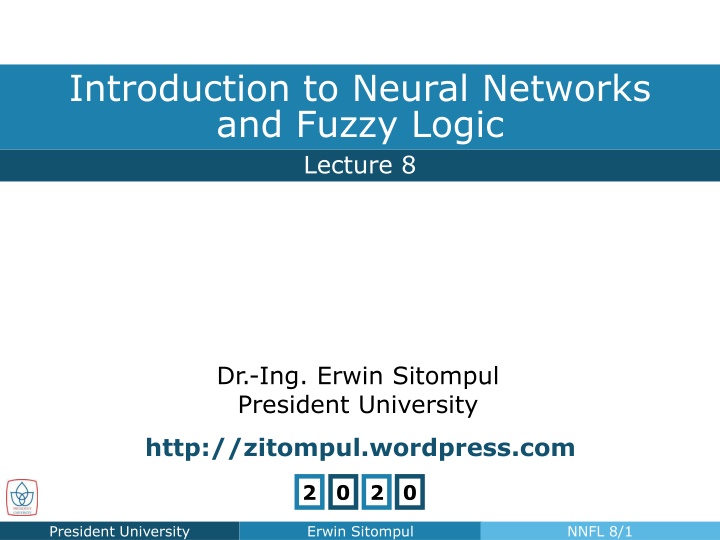
Neural Networks and Fuzzy Logic Concepts
Learn about neural networks and fuzzy logic through this insightful lecture by Dr. Erwin Sitompul from President University. Explore topics such as experimental modeling, activation functions, and the structure of biological and artificial neurons. Gain an understanding of how neural networks can be utilized for empirical phenomenon measurement and mathematical model validation.
Download Presentation

Please find below an Image/Link to download the presentation.
The content on the website is provided AS IS for your information and personal use only. It may not be sold, licensed, or shared on other websites without obtaining consent from the author. If you encounter any issues during the download, it is possible that the publisher has removed the file from their server.
You are allowed to download the files provided on this website for personal or commercial use, subject to the condition that they are used lawfully. All files are the property of their respective owners.
The content on the website is provided AS IS for your information and personal use only. It may not be sold, licensed, or shared on other websites without obtaining consent from the author.
E N D
Presentation Transcript
Introduction to Neural Networks and Fuzzy Logic Lecture 8 Dr.-Ing. Erwin Sitompul President University http://zitompul.wordpress.com 2 0 2 0 President University Erwin Sitompul NNFL 8/1
Neural Networks Introduction Introduction to Neural Networks Empirical Phenomenon measurement Data Theoretical modeling Experimental modeling validation Mathematical Model Validation: Generally, means confirming that a product or service meets the needs of its users. Testing whether the mathematical model is good enough or not to describe the empirical phenomenon. President University Erwin Sitompul NNFL 8/2
Neural Networks Introduction Experimental Modeling Experimental modeling consists of three steps: 1. The choice of model class 2. The choice of model structures (number of parameters, model order, time delay) 3. The calculation of the parameters and time delay. The model may be chosen to be linear, nonlinear, or multi locally- linear. A-priori (prior, previous) knowledge of the system to be modeled is required in most cases. Artificial Neural Networks (or simply Neural Networks) offers a general solution for experimental modeling. President University Erwin Sitompul NNFL 8/3
Neural Networks Introduction Experimental Modeling Using Neural Networks A neural network is a massively-parallel distributed processor made up of simple processing unit, which has natural propensity for storing experiential knowledge and making it available for use. It resembles the brain in two respects: 1. Knowledge is acquired by the network from its environment through a learning process. 2. Interneuron connection strengths, known as synaptic weights, are used to store the acquired knowledge. President University Erwin Sitompul NNFL 8/4
Neural Networks Introduction Biological and Artificial Neuron dendrite Structure of Biological neuron soma axon synapse 1x Activation function w 1 k Structure of Artificial neuron w ky 2x ( ) f 2 k net w km kb m = + x net w x b m ki i k 1 = 1 i = ( ) ky f net President University Erwin Sitompul NNFL 8/5
Neural Networks Introduction Activation Function Any continuous (differentiable) function can be used as an activation function in a neural network. The nonlinear behavior of the neural networks is inherited from the used nonlinear activation functions. y y y y 1 1 x x x x 2 e 1 e 2 e = = = = = =+ ax = = ( ) f x y ( ) f x 1 ( ) f x y y ( ) f x y x x 1 + 2 x 1 Tangent sigmoid function Logarithmic sigmoid function Radial basis function Linear function President University Erwin Sitompul NNFL 8/6
Neural Networks Introduction Network Architectures Single layer feedforward network (Single layer perceptron) Input layer Output layer Multilayer feedforward network (Multilayer perceptron) Input layer Hidden layer Output layer President University Erwin Sitompul NNFL 8/7
Neural Networks Introduction Network Architectures Diagonal recurrent networks Fully recurrent networks Input layer Hidden layer Output layer Input layer Hidden layer Output layer 1 z 1 1 z z 1 z Delay element in a recurrent network President University Erwin Sitompul NNFL 8/8
Neural Networks Introduction Network Architectures Elman s recurrent networks Jordan s recurrent networks z 1 z 1 z 1 z z 1 1 z 1 President University Erwin Sitompul NNFL 8/9
Neural Networks Introduction Preparation Assignment Install Matlab in your notebook. From now on, you do not need Simulink anymore. You will only need Matlab workspace. Quizzes and final exam will require Matlab. Please start to download Matlab now. Read the Intro to Matlab , and do the 2 assignments given. Submit via Google Classroom. President University Erwin Sitompul NNFL 8/10

